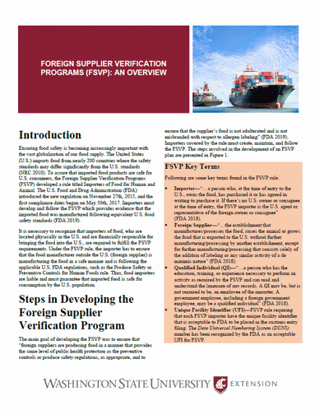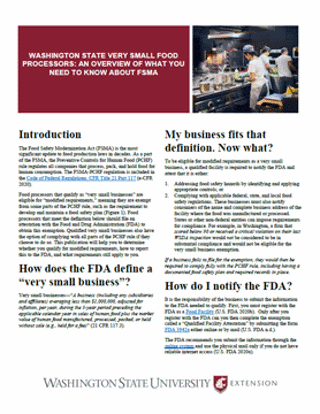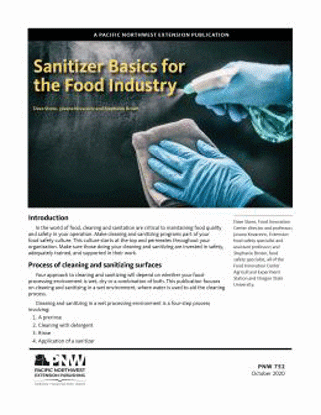You have no items in your shopping cart.
Recently viewed products
Food Products
Food Products
Using and Caring for Your Pressure Canner
Pressure canning is the only recommended method for canning meat, poultry, seafood, and vegetables because of the high temperature required to ensure against botulism poisoning. This publication describes canner types, safety features, maintenance needs, and provides step-by-step illustrated use instructions.
$0.00
Foreign Supplier Verification Programs (FSVP): An Overview
Ensuring food safety is becoming increasingly important with the vast globalization of our food supply: learn what the FSVP rule is and what it does.
$0.00
Washington State Very Small Food Processors: An Overview of What You Need to Know About FSMA
How does the Food Safety Modernization Act (FSMA) affect very small food processors? This question answered, and more, in this pub.
$0.00
Starting a Community Gleaning Program
Communities across the U.S. utilize gleaning as a way to address food insecurity and food waste: learn how your community can start a gleaning program.
$0.00
Current Good Manufacturing Practices: An Overview
The Current Good Manufacturing Practices (CGMPs) are vital to food safety systems: learn the minimum requirements—outlined in this publication.
$0.00
Food Safety Hazards: An Overview
Preventing food contamination begins with production: learn in-depth information covering biological, chemical, and physical hazards in this publication.
$0.00
Sanitizer Basics for the Food Industry
Cleaning and sanitation are critical to maintaining quality and safety in your food industry operation. Make cleaning and sanitizing programs part of your food safety culture. Here's how to make sure those doing your cleaning and sanitizing are invested in safety, adequately trained and supported in their work.
$0.00
Fruit Pie Fillings for Home Canning
Imagine using home-canned fruits in pies, pastries, parfaits, cobblers, crisps, or even as a topping for pancakes. Recipes for home-canned fruits found here!
$0.00
Food Safety Considerations for Postharvest Washing of Produce and Sanitation of Packing Areas, Equipment, and Tools
Find out how your farm or packinghouse can develop a more robust sanitation program in this publication, with a focus on chlorine and peroxyacetic acid (PAA).
$0.00










